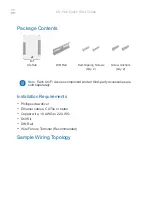UM10208_2
© NXP B.V. 2007. All rights reserved.
User manual
Rev. 02 — 1 June 2007
3 of 362
1.
Introduction
The LPC288x is an ARM7-based microcontroller for portable applications requiring low
power and high performance. It includes a USB 2.0 High Speed device interface, an
external memory interface that can interface to SDRAM and Flash, an MMC/SD memory
card interface, A/D and D/A converters, and serial interfaces including UART, I
2
C, and I
2
S.
Architectural enhancements like multi-channel DMA, processor cache, simultaneous
operations on multiple internal buses, and flexible clock generation help ensure that the
LPC288x can handle more demanding applications than many competing devices. The
chip can be powered from a single battery, from the USB, or from regulated 1.8 and 3.3V.
2.
Features
•
ARM7TDMI processor with 8 kB cache operating at up to 60 MHz
•
1 MB on-chip Flash Program Memory with 128-bit access for high performance
•
64 kB SRAM
•
32 kB ROM
•
On-chip DC-DC converter can generate all required voltages from a single battery or
from USB power
•
Multiple internal buses allow simultaneous GP DMA, USB DMA, and program
execution from on-chip Flash without contention.
•
External memory controller supports Flash, SRAM, ROM, and SDRAM.
•
Advanced Vectored Interrupt Controller, supporting up to 30 vectored interrupts
•
Innovative Event Router allows interrupt, power-up, and clock-start capabilities from
up to 105 sources
•
Multi-channel GP DMA controller that can be used with most on-chip peripherals as
well as for memory-to-memory transfers.
•
Serial Interfaces:
–
Hi-Speed or Full-speed USB 2.0 Device (480 or 12 Mbits/s) with on-chip PHYsical
layer
–
UART with fractional baud rate generation, flow control, IrDA support, and FIFOs
–
I
2
C Interface
–
I
2
S (Inter-IC Sound) interface for independent stereo digital audio input and output
•
Secure Digital (SD) / MultiMediaCard (MMC) memory card interface
•
10 bit A/D Converter with 5-channel input multiplexing
•
16 bit stereo A/D and D/A converters with gain control and optional DMA
•
Advanced clock generation and power control reduce power consumption
•
Two 32-bit Timers with selectable prescalers
•
8-bit LCD interface bus
•
Real Time Clock can be clocked by 32 kHz oscillator or another source
•
Watchdog Timer with interrupt and/or reset capabilities
UM10208
Chapter 1: Introductory information
Rev. 02 — 1 June 2007
User manual

















